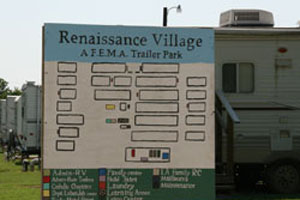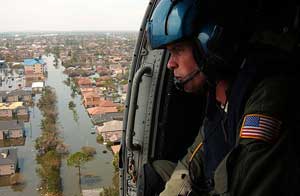
Photo: Sacajawea Hall
“That’s President Bush hugging me. See how tightly he’s hugging me?” It was the chilly end of 2006 in Baker, Louisiana, when Lena Beard asked me this, proudly waving a newspaper clipping my direction as we talked in her still-temporary home. The fading photo, taken the same day the mother of two took refuge on a mattress in a church after Hurricane Katrina, had served as proof after the levees burst that she was going to be okay. “I’m a veteran who has served my country and put my life on the line. I believed my country would take care of me and my family,” she said.
But three years after natural disaster stripped Beard and her sons of their house in New Orleans, she is still not okay. Unable to find a place she can afford after being evicted this summer from Renaissance Village, the largest FEMA trailer park in the country, the Beard family is contemplating a move next month into a homeless shelter.
I first met Beard a year and a half ago, while she was living in one of the 75,000 toxic trailers issued to Katrina evacuees. Ninety miles from New Orleans, she had grown discouraged and depressed after struggling with a three-hour commute each way trying to find work in her home city. She and her family had occupied the “temporary” shelter since October 2005. The day we met was the first day she had come out of it in a month. “I’m not proud that my children see me staying in bed all day, but I don’t know what to do. I just don’t,” she told her neighbors in December 2006, at a residents’ meeting of Renaissance Village. “I feel you honey, I feel you,” came the sympathetic response. Cold winter winds whipped past the flaps of the big white tent where Beard and the other residents were gathered.
Like others in the room, also evacuees from a poor and heavily African American neighborhood in New Orleans, Lena had received a trailer for herself and her two sons. The trailer was approximately 8 foot by 32 foot, with two sectioned-off ends that served as bedrooms. Even if she was watching TV in her room with the flimsy door shut, everyone in the trailer could hear what the other was doing. “My children used to have their own rooms,” Beard told me of the home she used to own. “And they both had computers.” No one wants to be a homeowner again more than she does.
From February 2007 through the summer months, Beard actively pursued various options to move her family back to New Orleans. She commuted in on weekends to work a bar job on Canal Street, which didn’t last long due to health issues that made it hard for her to stand for eight consecutive hours. In July 2007, just one month shy of her two-year displacement anniversary, a final housing option fell through. With no job, and having spent down the last of her savings in the years since the storm, she was unable to come up with the money to cover a security deposit and the first and last months’ rent. She was devastated.
But she was not alone. In the years after the storm, moving displaced low-income families back to New Orleans has become less and less realistic. Yes, 92 percent of hotels in New Orleans were open by mid-2007, but by June 2008, 40 percent of public schools remained closed. The number of public buses up and running is still nowhere near pre-Katrina levels.
In the fall of 2007 the number of active trailers still numbered more than 50,000. By February 2008, when CDC tests confirmed high levels of formaldehyde in FEMA trailers across Louisiana and Mississippi, FEMA began an aggressive push to shut down its trailer parks and “relocate families into safer and more permanent housing.” In the first quarter of 2008, FEMA displaced over 10,000 trailer residents. But even after the formaldehyde scandal had broken, the cramped and toxic trailers were the only security most residents had. “This is home, and I ain’t going to move into any slum just because FEMA tell me I have to,” Beard lamented to me in early 2008, referring to the apartments FEMA had on its lists of available long-term rentals.
Beard received a knock at her trailer door one June morning and was told she had two days to pack her things. After two days she and her family were moved into a motel and given a month days to find alternative accommodation. “I’m so tired from all this,” Beard told me then, in the motel room that housed the belongings she was able to salvage from her trailer before being locked out of it. “I just want my family to live in a decent home after all we’ve been through, so we can rebuild our lives. Is that too much to ask?”
This summer, FEMA spokesperson Gina Cortez told Mother Jones, “FEMA has closed 106 of its 111 group sites in Louisiana. Renaissance Village is one of them.”
Beard’s was one of the last five families to leave the trailer park.
Cortez claims FEMA has helped “all eligible trailer residents transition into long-term housing,” but ask around the motels where former Renaissance residents have gone after 30 days, and you hear a different story. While some have moved to homes of relatives in other states, others are living in cars, or have joined the rapidly growing New Orleans homeless population.
FEMA reiterates that its mission, beyond meeting emergency needs, is to simply complete infrastructure repairs and return a disaster area to its predisaster state. The agency won’t build new housing for displaced residents, even if it could be done for less money than what it costs to temporarily house people, because it’s outside their purview. But if FEMA isn’t responsible for finding these people housing, who is?
Beard and her family are still scrambling to find out. She had hoped to move into a lovely house with a yard near Renaissance Village—Catholic Charities even paid the landlord a security deposit—and she thought she could afford to move in. But due to what she says is a technical error, FEMA has deemed her ineligible for housing assistance, and as a result the lease fell through. While she searches for housing she can afford, her home state is being rebuilt around her. Her final eviction from the motel will come this week, just shy of the three-year anniversary when she lost her home to Hurricane Katrina.














